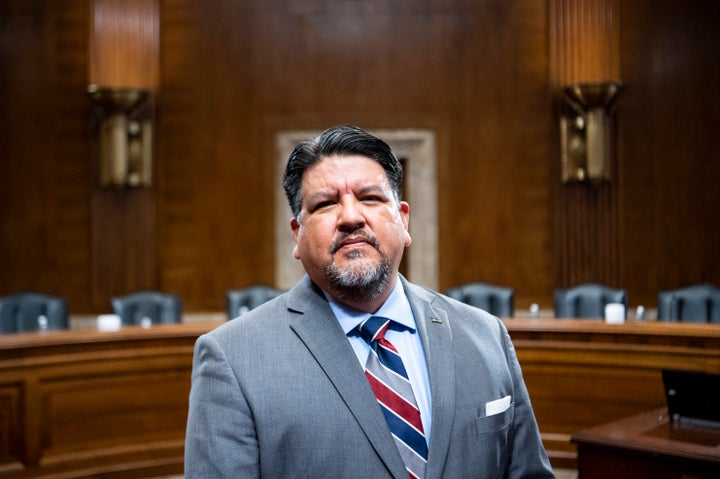Interior Secretary Deb Haaland announced Wednesday that the National Park Service is launching an initiative with Native American tribes to tell “a more complete story of American history” at the country’s 428 national park sites.
“I want to talk about how we tell our stories,” Haaland, who is the first Indigenous U.S. Cabinet secretary, said in remarks at the White House Tribal Nations Summit.
“There are parts of our history that are painful, but they do not define us,” she said. “We define ourselves by the world we collectively build for current and future generations. It is up to all of us to tell our stories. And not just the stories of the bad times — but of those that we celebrate. Those that show our resilience, our strength and our contributions.”
In that vein, Haaland announced that the park service is teaming up with tribes and academics for a theme study on the Indian Reorganization Period, “one of the most consequential periods of our history.” The centerpiece of this era, which spanned from the 1930s to the 1950s, was the 1934 Indian Reorganization Act — a federal law also referred to as the Indian New Deal that enabled tribal self-government and focused on improving the economic and social conditions of Native Americans.
“We saw — for the first time since colonization — federal support for Indigenous cultures, economic recovery, self-determination and governance,” said the interior secretary. “While injustices and the continued implementation of assimilation policies persisted in many Indigenous communities, this is a period that deserves our attention. I look forward to seeing what the service creates with the help and input of our communities.”
The country’s national park sites are all, in a sense, sites of storytelling. Every year, the federal agency logs hundreds of millions of visits at its parks, and each site, with its placards and monuments, tells a story about the history of the region. Often missing at these sites, though, are the stories from the Indigenous peoples who lived on that land for thousands of years, way before colonizers came and claimed the land as their own.
HuffPost talked to National Park Service Director Charles Sams about what the new theme study will do, why it matters that Indigenous people be given the chance to tell their stories about the land in national parks, and what it means for how visitors will experience national parks after it is done. Sams, like Haaland, brings a fresh perspective to the idea of who tells the story of American history, as the first Indigenous person to lead the park service.
This Q&A has been lightly edited for brevity.

Tell me what this theme study means and how it came about.
When I took this position, the secretary charged me to tell America’s story fiercely, regardless of the bad, the ugly or the good. To dig for the truth and get it out there, so we can see a reflection of ourselves in our stories and understand who we are and what our history has been as Americans.
Early on, she asked me to review how we are doing storytelling across Indian Country. As you know, our parks tend to tell a story in the past tense. Sometimes they don’t really fully recognize that tribal sovereign nations exist and that they have a seat at the table in partnership with the federal government. So she asked myself and Assistant Secretary Bryan Newland to look at our history as Native people and look at the different potential themes for discussion.
When you look at the American history that every American kid has to take growing up, there is pre-contact [the era before the arrival of Europeans], point of contact, Colonialism, Revolutionary War, post-Revolutionary War, antebellum Civil War, Reconstruction. That’s the timeline.
The timeline in Indian Country is a little different. We look back tens of thousands of years. Then we have contact, then we have colonization of America. But then things look a little different as we look into assimilation, removal and annexation of our lands, prior to treaty-making. Then there’s the time period in American Indian history of the Indian Reorganization Act. Then we’re looking at self-determination and what do tribes look like today.
So [Assistant] Secretary Newland and I took a good look at our history and started to see where there might be gaps to tell a more complete history throughout the National Park Service. We recommended the Indian Reorganization Act, from the 1930s to the 1950s, and will concentrate on our ability to tell the modern era of tribal governments — how did tribes transition, what does that look like, what has happened since the Indian Reorganization Act.
What did the Indian Reorganization Act allow tribes to do?
They could adopt a constitution provided by the Bureau of Indian Affairs. They could set up a business council rather than a constitution to deal with commodities that come off the reservation. They could preserve a more traditional form of government; a number of tribes did do that, like in California or the Pueblo tribe in the Southwest — they created a governor system. Or, they could say: “We don’t want any of these things. We want to keep our form of government.”
Our theme study will look at this time period, what it meant for tribes, how they were able to use or not use the Indian Reorganization Act to form modern governments.
What is an example of how this work with tribes will translate to updates in parks?
The Confederated Tribes of the Umatilla Indian Reservation, where I’m from, we have a peace treaty from 1855, with the Walla Walla Tribe. It says that I reserved all my rights to places to hunt, fish and gather. So if you travel to Yellowstone National Park, right now you don’t see anything on that. When the modern government came into effect, their charge was to protect and enhance our treaty rights. So you might see a placard offering a more complete story about my tribe who, under their treaties and modern forms of government, were able to ensure that tribal members could still hunt and gather in places such as Yellowstone.
What are some of the ugly things that people might learn?
The Indian Claims Commission was created in 1945, set up in 1946 and set up as an opportunity for tribes to bring before the federal government any and all claims of wrongdoing in a way that the federal government would recognize and acknowledge that it did something wrong to tribes and to compensate them for that loss.
The ugly part is that many times during the Indian Claims Commission, it was just a monetary reward given and not land back. For some tribes, that was not their purpose. They thought they were going to be made whole, with their lands returned, or a better understanding of their rights would come about. But many times, their rights were lost.
Is this kind of detail something that might appear on a placard in a national park?
We’re talking with tribes. That might be something that comes of it, or a new historical landmark. The recommendations [for the stories being told at parks] will come directly from tribes. That’s what the study will show. Across Indian Country, what stories do they want to tell?
The recommendations could end up becoming a park. They could end up having consideration before Congress.
How long will this process take, from soliciting story ideas from tribes and translating them into historical information shared in parks?
It can take a couple of years. We have to complete the theme study, and then report it to Congress and the president.
So if Donald Trump became president after the 2024 election, is this something that he could potentially stop while it was underway if he didn’t support doing it?
I don’t know of a theme study that’s never been completed.
We’ve done several in the past. If you go to the National Park Service website and put in “theme studies,” you can see the theme studies we’ve done. Contact with American Indians. Clash of cultures on trails. African American outdoor recreation. Astronomy and astrophysics. These types of theme studies, they go through the academic process, but they are community-driven in terms of the holders of these stories and where they wish to tell them.
Anything else you want to say about this project?
When I was a young sailor [in the Navy] at age 18, I was stationed in Virginia. There was a two-week break where my buddies and I went from Maine to Florida, visiting as many national parks and monuments as we could. That left a truly deep-seated understanding for me of the National Park Service. It really is a storyteller. From the Colonial time period, in Virginia to Florida, to the Revolutionary War, we have parks up and down the Eastern Seaboard that give context on who we are as Americans.
Many times, I feel like the parks are part of America’s consciousness. They don’t try to lead you to a conclusion. They try to get you to understand that time period. It should impact you so you carry those stories with you when you leave the park.

